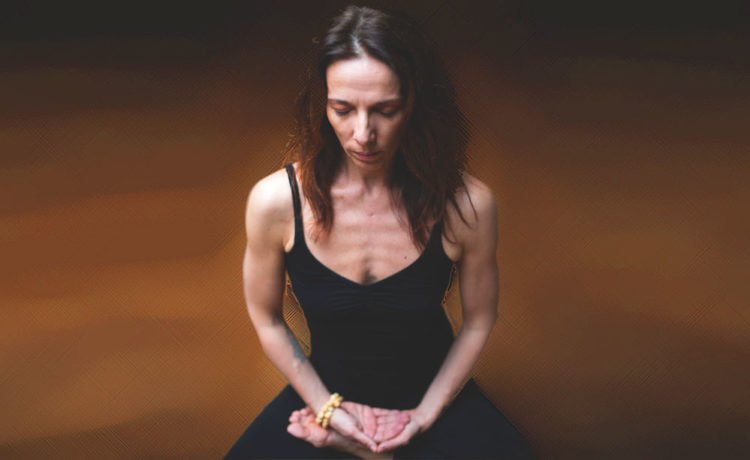
Savasana
By Keely Rakushin Garfield, November, 2016
Once upon a time, I went to a party. There were a lot of other yogis in attendance, and after a good amount of apple cider and vegan carrot cake, merriment was at a high point. Someone asked, “What’s the hardest pose?,” and the challenge was on: One by one, the yogis proceeded to demonstrate their definitive answers, showing off really hard stuff — visvamitrasana, vatayasana, and mukta hasta sirsanana. (Look, Ma! No hands!)
Biding my time, I waited until the shenanigans had peaked, and then made my move. Ceremoniously, I lay down, feet a little apart, arms a few inches from my sides with my palms upturned, chin gently regarding my chest, ears equidistant to each other. Within me, I beheld my breath, and let my muscles fall away from my bones. As a finale, I disappeared completely. Well, so to speak. Recognizing a slam-dunk, the enlightened company at once exclaimed, “Savasana! Of course! The hardest pose of them all!” I rest my case.
As I write this, I am in England with my family. Too soon to coin it “recently,” my father passed away on October 11th. Safe to say, he has reached his final rest.
Today I wandered out on the Downs and lay in the grass. I arranged myself as comfortably as I could, including all of the asymmetry in my body, my mind, and my heart. I scanned from head to toe, looking for something other than the natural lop-sidedness of things. I was searching for a sense of evenness, or sama — a Sanskrit word that essentially means “same,” or “equal.” Since everything is marked by impermanence, and moment-to-moment the world spins, what is it that remains the same?
Savasana offers us a glimpse of an unperturbed place — in Rumi’s words, “Out beyond ideas of wrong-doing and right-doing” — where we may subtly perceive the deep mystery of our being. We realize the miracle of our existence — a state of grace, actually. Lying on the earth under the sky, nothing added, nothing taken away. There is no more practice, no one to practice. You have arrived. You are the practice.
Still lying in savasana, I opened my eyes. Just above, a swarm of late-fall fruit flies circled my head, vying with each other for my attention. I pursed my lips and blew a long, reluctant exhale toward them. My breath, becoming one with the wind, dispersed the flies. I had a vision of being dead, and coming back to life.
Savasana, or mrtasana (mrt meaning “death”), also known as “corpse pose,” ultimately presents us with a chance to rehearse for our last curtain call, only without the drama. I think of words by the poet Shi Te, “Not going, not coming, rooted, deep and still.” This equanimity is savasana.
So savasana has everything to do with preparing us for death, yet it’s equally a powerful prescription for life. The pose promotes relaxation for mind and body, helps to alleviate anxiety, depression, and stress, and cultivates peace and calm, or, at the very least, acceptance. While the pose can help reduce fatigue and insomnia, it has nothing to do with taking a nap or zoning out after an exhilarating asana practice. If you do fall asleep, no need to berate yourself, just try to have an early night. But so you don’t miss the whole show, resolve to roll your mat out again in the morning.
Savasana occurs in that gap between coming and going. Richard Freeman says this gap is where “observed content is released and dropped.” In Buddhist terms, it’s shunyata — the awareness that all things are intrinsically empty. It’s reached when one is not attending to any themes. The paradox is that savasana, for many, is anything but empty; instead it’s filled with a sense of what B.K.S. Iyengar described as “illuminated emancipation, freedom, unalloyed and untainted bliss.” There’s room for it all in savasana.
But what if you aren’t one of the lucky ones who just plop themselves down in savasana and feel instantly at home? Trust me, I know where you’re coming from: I witnessed the catastrophic events of 9/11 firsthand while standing in the WTC Plaza with my infant daughter in a stroller. I was shaken and stirred to my core. But I continued to get on my mat — continued to lean in and take a closer look. For an entire year post-9/11, I practiced savasana with my eyes open. Sometimes I had to just sit up. An unexamined life, it is said, is not worth living. Sometimes that examination takes place with gritted teeth and blurred vision. Rumi, again: “When the soul lies down in that grass, the world is too full to talk about.”
Anyway, you begin to see why savasana might be the hardest pose, don’t you? I mean, who in their right mind is going to voluntarily lie down on the ground, belly-up, heart exposed, eyes closed, in a room full of strangers, and hang out with absolutely everything and nothing? The physical, emotional, mental, and spiritual challenge of savasana is immense. As a yoga teacher, watching my students in savasana is humbling. It’s an honor to witness the human condition — vulnerability and valor side-by-side.
Savasana is generally suitable for everyone, though one size doesn’t fit all. Practice according to time, place, and circumstance. Try to position your body so that it feels balanced, neutral. Let the earth hold your weight, and simply notice that you’re breathing. No need to reach for anything, or push anything aside. Let the tongue rest on the bottom of your mouth, as though it, too, were in savasana. Relinquish the desire to speak, to see, to hear. Let your hands serve the sky, and your feet serve the earth. Relinquish the energy of your arms and legs. (You can place a bolster on the tops of your thighs to help with this, or under your knees, if you experience any discomfort in your back.) If you’re pregnant, elevate your head and torso. If you’re sad, keep your eyes open and your gaze gentle. If you’re scared, make sure you’re covered with a blanket, or near a wall.
Whatever you do, remember to practice for all sentient beings. Don’t be afraid to let anything that’s holding you back from truly living, die. Realize that (in Rumi’s words) “ideas, language, even the phrase each other, doesn’t make any sense.”

